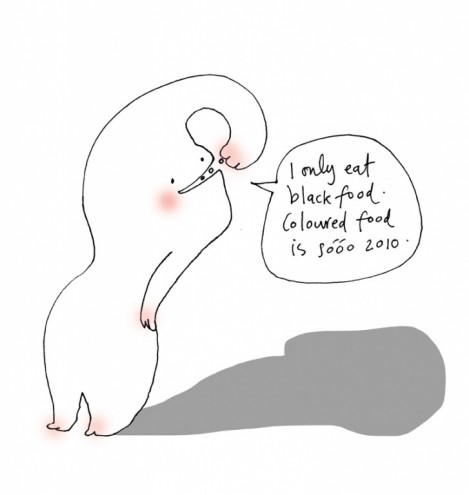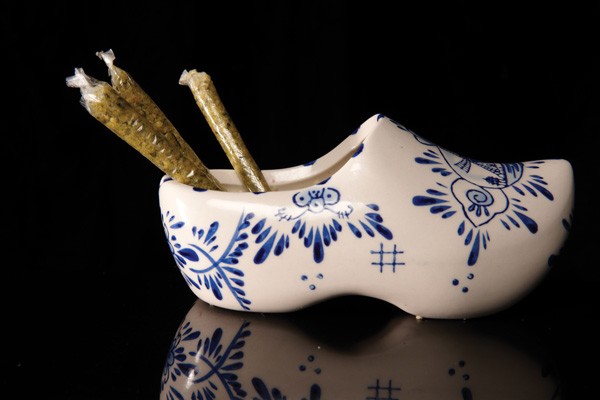First Published in
What distinguishes human beings? Their ability to tweet digitally? Walkon dizzying heels? Tell Freudian jokes? Or, as food designer Martin Hablesreiter says – and I may be freestyling a bit here – our incessant drive to change the appearance of our foods into shapes that correspond with our lifestyle and the zeitgeist?
I’m with Hablesreiter. If only because this supports my personal adagio that food is equal to fashion. Like fashion, the way we eat, prepare and design our food is an early signal of economic, political and demographic changes in society.
In the first edition of my yearly stylebook on food trends, What (Not) To Eat 2010, I quoted the German Princess Palatine, who lived from 1652 to 1722. In a letter to her family back in Germany, this sister-in-law of Louis XIV writes about the food trends she introduced to the royal fashionistas at the Versailles court: “I have also made Westphalian-type raw hams fashionable here. Everybody eats them now, just like many of our German foods: Sauerkraut!”
In a time when sophistication, glamour, bling and other ostentations reflected in the silver plates that were passed around at the exuberant dinner parties of the court, a basic peasant-like food such as sauerkraut came into fashion. Was the fermented cabbage welcomed as an exotic novelty that contrasted so refreshingly with the Sun King’s craving for the freshest possible greens from his own garden? Or might it have been a signal of times that were a-changing
Like the Sun King, we are now looking for the freshest seasonal experiences. We want to gather our foods in the wild or, at least, on our own rooftop garden. Though, contrary to this 14th Louis who put sculpted food very much in vogue, today we like to eat our foraged grub without too many alterations. Holistic and recognisable, showing its humble descent: From a whole pig on the dinner table at The Breslin restaurant in New York, to an entire carrot on many other restaurant plates – including its foliage, skin and even the earth from which it was drawn.
But while we, the followers of food fashion, savour the freshest possible, forward-looking chefs are wildly experimenting with matured foods. For, again, times they are a-changing. “We’ve always thought that food needs to be eaten as young and freshly as possible. We were wrong!” says the visionary Nordic forager chef René Redzepi from his Copenhagen restaurant, Noma.
In a no-waste attempt to stretch food across seasons and make inedible parts edible, he now develops what he calls “vintage” foods by taking traditional preserving methods like dry-aging and fermenting to a new level. And, while he’s at it, thereby taking slow food to a novel height by making potatoes, seaweeds and carrots ripen like wine, sauerkraut or (Dutch) cheese for up to two years. In this extended ripening period, the fare develops a personal taste history.
This synchronises with our zeitgeist that prescribes that all things we wear, sit on, live in, drive with, eat from, listen to or watch, posses a vintage feel with a unique history. In rebellion against all industrial stuff that comes in anonymous millions, chefs and food designers alike want to take food out of obscurity and give it a “face”. Not just the face of the farmer who produced it. But also in itself.
After a period of shaping foods into abstract dots, squares and triangles, chefs now want to show the food as it really is. Like the fashion designers that use old, worn materials, they want to show the wear and tear. Unplugged. From Redzepi’s vintage carrot that was buried underground for two years, to the compost cookie of New York chef David Chang's Momofuku Milkbar. Chang’s cookie looks like it’s been rescued from a fashionable compost heap on some NYC apartment balcony, containing recognisable residuals of coffee, pretzels, potato chips, oat meal and chocolate sprinkles.
Others also provide their ingredients with a history. Named after the Dutch 17th-century Verenigde Oost-Indische Compagnie that sailed to the East-Indies, in the London-based Punch House VOC, complete cocktails and punches are being aged in old barrels.
But how to fit in those chefs who, like way back at the Versailles court, sculpt their food into figurative works of art? The edible rosary by Dutch chef Sergio Herman, the praying hands by the Israeli-Dutch Moshik Roth or the edible joint by Jonnie Boer can simply be seen as a consequence of food as a storyteller. But the ultimate example of edible storytelling might very well be jellifying, the food preserving method that too was fashionable at the Louis XIV court. By making jellies out of beets or any other food, the Jelly Mongers in London and Being a Jellybar in Amsterdam visualise complete, though wobbly, stories that comment on our society.
Although the fooderati now forage in the history of food, picking what they need to shape the current vintage-driven zeitgeist, no one just simply copies and pastes the old. Vintage never means “unchanged”. It means touched by the signs of times. Food is fashion!
Marjan Ippel is food trend curator cum food writer for Dutch titles such as Delicious, Winelife and Sabor; founder of the Underground Boerenmarkt and author of the yearly stylebook on food trends What (Not) To Eat (now available as an app). Website: www.talkinfood.nl











